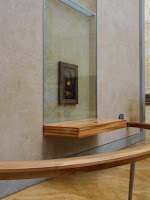 Le Musée du Louvre is simply incredible. The palace began as a fortress in the late 12th century. In 1682, Louis XIV moved to Versailles and the Louvre became a place to display the royal collections. It was during the French Revolution that it was decided to turn it into a museum. Today, it averages 15,000 visitors per day and is the world's most visited museum.
Le Musée du Louvre is simply incredible. The palace began as a fortress in the late 12th century. In 1682, Louis XIV moved to Versailles and the Louvre became a place to display the royal collections. It was during the French Revolution that it was decided to turn it into a museum. Today, it averages 15,000 visitors per day and is the world's most visited museum.
The place is just massive. There are 35,000 pieces, from prehistory through the 19th century, in an area over 652,000 sq. feet. (60,600 sq. meters). With multiple floors in every wing it is easy to get turned around...especially when you're looking for something in particular.

You really need at least a day to go through the museum without feeling too rushed. But even then, you will go through art overload! The best thing is to figure out what you want to see and then afterward you can just explore. There is just no way to see everything, and appreciate what you're looking at, in a single visit.

In the late 1980s the giant glass pyramid in the central courtyard was unveiled. The inverted pyramid was unveiled in 1993. Many people were up in arms about the pyramids and thought that this would be the start of the museum's decline. It doesn't seem so because attendance has doubled since they were completed.
 Here are some of the museum's best pieces...at least for me. I wonder if it has anything to do with all of the humanities and world civilization courses I was required to take in college?
Here are some of the museum's best pieces...at least for me. I wonder if it has anything to do with all of the humanities and world civilization courses I was required to take in college?
The most famous piece at the Louvre, without a doubt, is Leonardo da Vinci's 16th century Mona Lisa. To be honest this was the one thing that was kind of a let down. I always imagined that it would be bigger but it's actually quite small. This is also the only exhibition that you can't get very close to.
 The Venus de Milo is one of the world's most famous ancient Greek sculptures. It was created some time between 130 - 100 BC and it was added to the museum's collection during the reign of Louis XVIII. It's the 2nd most popular attraction at the Louvre.
The Venus de Milo is one of the world's most famous ancient Greek sculptures. It was created some time between 130 - 100 BC and it was added to the museum's collection during the reign of Louis XVIII. It's the 2nd most popular attraction at the Louvre. Psyche Revived by Cupid's Kiss, by Antonio Canova, shows the Neoclassical obsession with love and emotion. It was commissioned in 1787 and donated to the museum in 1824.
Psyche Revived by Cupid's Kiss, by Antonio Canova, shows the Neoclassical obsession with love and emotion. It was commissioned in 1787 and donated to the museum in 1824.
Liberty Leading the People by Eugène Delacroix commemorates the July revolution of 1830 that brought down Charles X. It's thought that this painting served as the inspiration for the Statue of Liberty.

The Code of Hammurabi dates back to around 1792 BC in ancient Babylon. It displays 281 laws on a 2.25 meter (~7.5 feet) pillar. The Babylonian king Hammurabi had the laws displayed so prominently so that no one could plead ignorance of the law.

The Winged Victory of Samothrace, also known as the Nike of Samothrace, is a 2nd century BC marble sculpture of the Greek goddess Nike. It was discovered in 1863 and estimated to have been carved around 190 BC. It has been in the Louvre since 1884.
























No comments:
Post a Comment